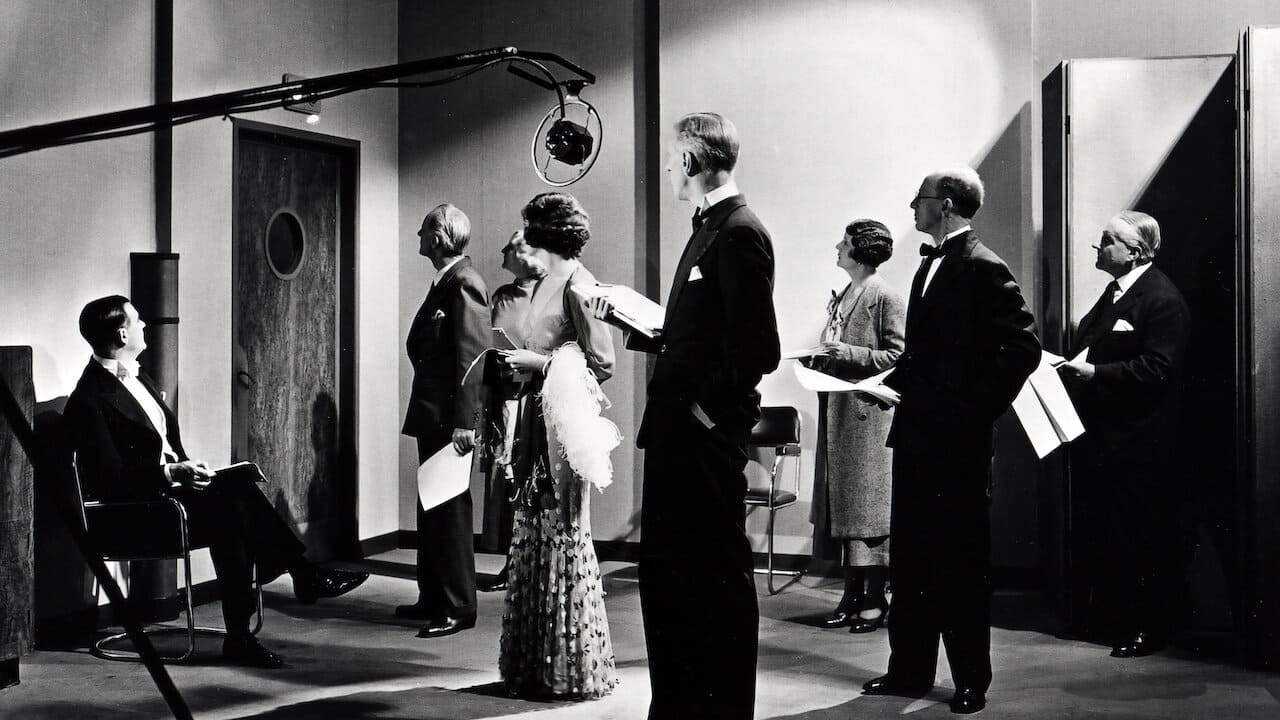Alicia
I love this movie so much
Dynamixor
The performances transcend the film's tropes, grounding it in characters that feel more complete than this subgenre often produces.
Calum Hutton
It's a good bad... and worth a popcorn matinée. While it's easy to lament what could have been...
lucyrfisher
It's great to see inside Art Deco Broadcasting House soon after it was built. It looks like a set from The Shape of Things to Come, while the male characters all wear faultless evening dress (not changed much since 1900) after six, and the ladies wear the rather frilly and fluffy fashions of the time.It is also illuminating if you are a fan of the detective stories of Ngaio Marsh, particularly Enter a Murderer (set in a theatre). Here we have the still rather melodramatic acting conventions, and a leading lady with a carefully genteel accent who strikes poses and delivers speeches in private life.Stock characters abound: the "silly ass" who gets lost on the way to the Variety show. (He's a terrible bore, though supposed to be funny.) Fortunately he hooks up with Miss Poppy Levene, a wise-cracking chorus girl who is going to get a few diamond bracelets out of him. She really is funny.Val Gielgud as the abrasive producer, explaining that you need to co-ordinate several studios to get "aural ambiance" or some such.The playwright, who is always ready with a Wildean wisecrack, puts literary characters like Lord Peter Wimsey and Inspector Alleyn in the context of their times.The gentlemen are unforgivably rude to "inferiors". As one of the doormen helps the leading actor on with his coat, the thespian snaps "Stop annoying me!" I rather liked Donald Wolfit as the bounder who is snubbed by the rest of the cast - shame he gets strangled so early.We get a good view of the chorus line rehearsing and performing just so that their taps could be heard behind the dance band.
writers_reign
This has real curio value for anyone interested in the early days of respectively radio and sound film. Val Gielgud who co-authored the screenplay unwisely allocated himself a leading role which explains all too well why he is best remembered as a producer. It remains a fascinating glimpse of Broadcasting House as it (presumably) was and the exhausting rehearsals undergone by a dance troupe (on radio) underline the Reithian standards that once obtained (including, of course, newscasters in full evening dress. We also learn where MGM got the idea of filming Lena Horne is stand-alone segments that cut be cut seamlessly when a film played in the Deep South; here Elizabeth Welch has a similar isolated sequence bearing no relation to the plot; she walks in, sings a song, Lazy Lady, and walks out again. This is her sole contribution to the film and quickly and easily removable as and when necessary. Donald Wolfit plays the luckless 'ham' actor (surely a comment on his theatrical appearances)who is killed for real on air whilst Jack Hawkins weighs in with a performance mannered beyond belief. One from the 'so- bad-it's-good' school and none the worse for it.
jonfrum2000
I always give early-1930s movies the benefit of the doubt, and I'm doing so here. An actor working alone in a radio studio room is murdered while reading his lines (in which his character is murdered). Someone in the studio building at the time killed him, but whom? There are only a few possible culprits, and most aren't very well defined characters. A few years later, this probably could have been a very good movie, but it's barely passable here. I suspect much of the appeal of this film when it was released came from the behind-the-scenes look at a working radio studio, with actors in multiple rooms, and orchestra in another, and crew in still others. You even get a song and a dance number, although the appeal of a dance number on radio, including dancers in full costume, escapes me.If you enjoy 1930s crime/mysteries, then this is worth a watch. The detective doesn't define himself particularly well, but the genre plays out reasonably true to form. I gave it a 6 for slightly better than average.
Peter Worsley
This is really two stories in one. The first is the underlying plot of a murder during a live radio broadcast of a play so that the actual death by strangling of Donald Wolfit (before he became famous), is the real thing. Having been previously castigated by producer Val Gielgud (who actually wrote the film storyline as well) for not gasping properly, he is summoned to be congratulated on his improved performance only to be found stretched out on the floor, dead. There are several plausible suspects who all had the opportunity and motive to commit the crime but the actual culprit seemingly has a cast iron alibi. His unmasking therefore comes as a genuine surprise with the final chase through Broadcasting House bringing about his demise when he enters a door without realising it is a live electricity station. The second story is that of the daily routine in Broadcasting House where we are treated to two top stars of the day, Elisabeth Welch and Eve Becke, delightfully singing to the accompaniment of Ord Hamilton at the piano and Percival Mackey's dance orchestra respectively. Interweaved and connecting both stories is a gormless intruder who goes all over the building in search of the Variety studio, upsetting everyone in the process and also becoming a prime murder suspect. Other people come and go, mischievously signing autographs outside the front door. A gripping film, the only disappointment being that the police inspector never reveals his evidence until right at the end, thus depriving the viewer of accurately guessing whodunit.

